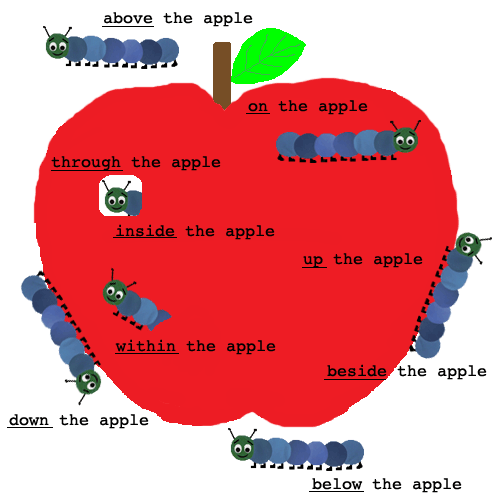Preview
This section will cover the following topics:
- the job of prepositions
- using prepositions to avoid common writing problems
The first five parts of speech we studied–nouns, pronouns, verbs, adjectives, and adverbs–are the foundation of a sentence. They tell us who is doing what.
The small dog is barking loudly.
But many sentences are more complex than simply who and what. We also want to know where and specifically when.
The small dog ran into the street. (where)
The dog barks every day at 7 a.m. (when)
What Is a Preposition?
A preposition is a word that shows the position of something or someone in space and time.
If you look at the word “preposition,” you’ll see the embedded word “position.” A preposition tells us where and when.
A prepositional phrase is a group of words that begins with a preposition, ends with a noun or pronoun, and does not include the verb or subject.
“into the street” is a prepositional phrase that shows where the dog ran. “at 7 a.m.” is a prepositional phrase that tells us when it barks. Notice that both phrases begin with prepositions (“into,” “at”) and end with nouns (“street,” “7 a.m.”), and neither includes the subject or verb of the sentence.
Here is another example:
The study rooms (on the first floor) (of the library) are full (in the morning).
In that sentence, each group of words enclosed in parentheses is a prepositional phrase: they all start with a preposition (“on,” “of,” “in”), end with a noun or pronoun (“floor,” “library,” “morning”), and don’t include the verb (“are”) or subject (“rooms”). The job of these prepositional phrases is to tell you where the study rooms are and when they are full.
Prepositions Show Position in Space
Here are some common prepositions that show positions in space:
| to | across | over | against | with |
| at | through | inside | under | within |
| in | beyond | between | beneath | without |
| on | among | above | around | below |
| by | near | behind | past | from |
Imagine a plane flying across a sky. We can change the plane’s position in space by changing the prepositions: above the clouds, below the clouds, within the clouds, between the clouds, past the clouds, behind the clouds.
Another way to remember prepositions about space is illustrated in this graphic. Where is the caterpillar in relation to the apple?

Prepositions Show Position in Time
Here is a list of common prepositions that show position in time:
| at | before | since |
| by | past | throughout |
| in | until | from |
| for | during | between |
| after | within | around |
Imagine that plane is about to land. We can change its position in time by changing prepositions: at 3 p.m., after 3 p.m., before 3 p.m., around 3 p.m.
Of, As, and Like
The words “of,” “as,” and “like” are also prepositions, but they don’t fit neatly into the space or time category. However, they are very common. For example:
book of essays, type of bicycle, give as an example, testify as an expert, think like a computer, disappear like magic
Just remember: “of,” “as” and “like” are also prepositions.
Why Bother?
Locating prepositional phrases will help you correct other parts of the sentence. For example:
In the rainy season, one of our windows leaked at all four corners.
If we isolate the prepositional phrases from the rest of the sentence, it is easy to find the verb and subject:
(In the rainy season), one (of our windows) leaked (at all four corners).
All we have left are the words “one” and “leaked.” “one” is the pronoun subject and “leaked” is the verb.
Identifying prepositional phrases can help writers correct things like subject/verb agreement problems, sentence fragments, and other common grammatical errors. (More about subjects and verbs in Ch. 4.)
Takeaways
- Prepositions show the placement in space or time of other elements in a sentence.
- Identifying prepositional phrases can help writers avoid other grammatical errors.

